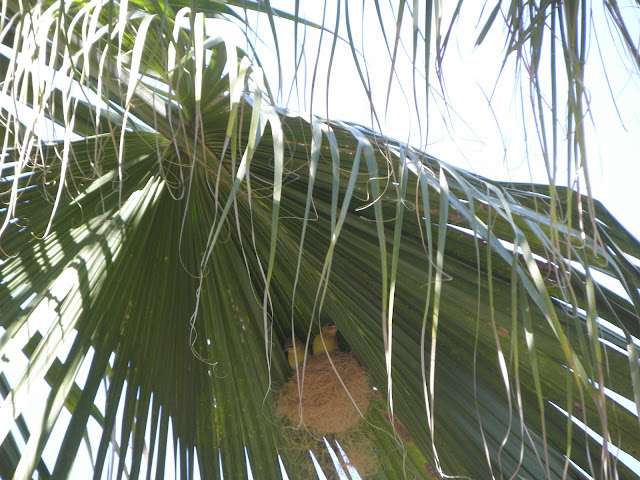They're Back!
In my garden, I start looking for Hooded Orioles at the beginning of March. The males are the first to arrive, somewhere between the beginning of the month and near the end. This year, they were a little late. The seasoned males guide the others up from Mexico to their breeding ground in Southern California. They can primarily be found within a few miles of the coast, especially around palm, eucalyptus, and sycamore trees, or in the canyons around the Anza Borrego Desert. A few make it up to the San Francisco Bay, and they are occasionally found as far north as Humboldt County and Vancouver, BC. Hooded Orioles are here because of the explosion of springtime insects that are the perfect food to raise one or two broods of chicks. Despite their almost constant presence at our nectar feeders, Hood Orioles spend the rest of the time gathering insects, as they make up 60% of their diet. Chicks, though, need an entire diet of insects to grow up fast and strong in the two weeks they are in the nest. Caterpillars are ideal baby bird food because they are soft and can easily be stuffed in willing mouths. Remember that when some of your plants get overrun with caterpillars. This spring largess is by design so many hungry babies can be fed. Your garden pests are feeding generations of songbirds.
Male Hooded Oriole S. Reeve
Most people can recognize these brilliantly colored birds. Like many songbirds, the males have brighter breeding plumage than the females, who are rather drab in comparison, with a dull olive green/yellow plumage. Juvenile males have a similar coloration to adult females. There are five subspecies of Hooded Oriole, with three occurring in the United States and all five in Mexico. They vary in their appearance by the amount of carotinoids in their feathers, giving them a bright yellow or bright orange coloration. The five subspecies of Hooded Oriole (Icterus cucullatus) are 1. I. c. culcullatus 2. I. c. sennetti 3. I. c. igneus 4. I. c. nelsoni 5. I. c. trochchiloides. In San Diego we see only Icterus cucullatus ssp. nelsoni. Unbelievably, this 7-8 inch long bird weighs less than an ounce, at 24 grams!
We see the males arrive first. They are scouting for the best nesting locations. Or rather, I usually hear them before I see them. I recognize their distinctive scolding and incessant chattering calls in an instant. If I see them, it is their nervous tail flicking and habit of constantly changing positions that get my attention. The males make great sentries at the nest and are quick to announce any threats. The male's song is a varied 3-4 second mimic of other bird's songs interspersed with whistles, a "wheet" call, and buzzing. Females sing too, but not as dramatically. Once, a nesting site is selected the female weaves a pouch nest in about four days. The nest is constructed of grasses, palm fibers, and lined with feathers and fur. She attaches it to the underside of palm leaves, although eucalyptus and sycamore trees can be used. One study found Hooded Oriole nests predominantly in Mexcian and California fan palms. The 3-5 eggs incubate for about two weeks and then both parents feed them until fledging in another two weeks. If the parents are up for it, they will raise a second nest of babies before flying back to Mexico in August.
In the summer, we usually have several nesting pairs of orioles draining our feeders. Unlike some members of the Icteridae Family (blackbirds, meadowlarks, and orioles), Hooded Orioles are thriving. Because of their varied diet and how they have learned to benefit from human habitation their numbers are increasing. Our house is surrounded by large Grevillea robusta that bloom in April. These sweet nectar-filled flowers are very attractive to orioles who use their brushy tongues to lap up the nectar. If they aren't there yet, I hope you see Hooded Orioles soon in your garden. As their nests are on the lower leaves of palms, please check before having your palms trimmed. Also, for their continued best health use only 100% cane (non-GMO) sugar in their nectar and organic grape jelly in the feeder.
Citations
Friedman, Nicholas R., McGraw, Kevin J. and Omland, Kevin E. History of mechanisms of carotenoid evolution in the New World orioles (Icterus). Comparatively Biochemistry and Physiology Part B: Biochemistry and Molecular Biology, Volumes 172-173, 2014, Pages 1-8.
Garrett, K. and J. Dunn. 1981. Birds of Southern California. status and distribution. Los Angeles Audubon Society. Los Angeles, CA.
Pleasants, Barbara Y. and Daniel J. Albano. (2001). Hooded Oriole (Icterus cucullatus) version 2.0. The Birds of North America. Cornell Lab of Ornithology, Ithaca, New York, USA.
Sibley, D. A. (2014) The Sibley Guide to Birds, second edition. Alfred A Knopf, New York, NY, USA.



